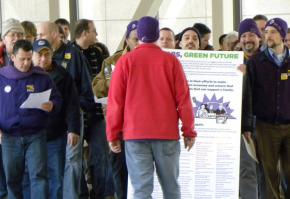A new script for labor in Minnesota
, a professor of history at Macalester College and author of Hard-Pressed in the Heartland: The Hormel Strike and the Future of the Labor Movement, reports on a successful contract campaign by custodians in Minneapolis.
THE MOST severe economic crisis since the Great Depression of the 1930s, the "Great Recession," has revealed the insecurity faced by working people.
After 40 years of neoliberal economic policies and practices, including free trade and the export of capital and jobs, contracting-out and contracting-in, deregulation, privatization and reductions in the government-provided safety net, many Americans are left with little or no protection.
Millions have lost jobs, homes, savings and health insurance. With the stock market crash, workers lost retirement nest eggs and their children's educational funds. In Minnesota alone, 50,000 families had their homes foreclosed upon in 2008 and 2009, and 500,000 individuals lost their health insurance.
While the residents of Main Street have borne the brunt of the Great Recession, Wall Street's large financial institutions and their executives have, for the most part, been able to insulate themselves from its consequences. Neoliberal policies and practices left most Americans vulnerable while making the rich richer.

Between 1979 and 2005, the mean after-tax income of the top 1 percent of income earners rose 176 percent, while that of the lower half rose less than 10 percent. In 1970, the average CEO earned 40 times as much as the average worker. By 2010, it has become nearly 400 times!
While the ceiling rose, the bottom dropped. The real value of the minimum wage fell by 35 percent. A recent study points out that 2 to 3 million workers are paid less than the legal minimum wage, and another 3 million are misclassified by their employers as "independent contractors," and thereby cheated out of benefits and overtime pay.
The net result? Some $19 billion a year that should be in workers' pay packets stays with their employers, a sum larger than any other form of larceny in the U.S.
Income inequality is small potatoes compared to wealth inequality, which provides those Americans at the top with a sizable cushion. Eighty percent of all the wealth in the U.S. is owned by the 10 percent at the top of our economic ladder, with some 38 percent of the wealth the property of the top 1 percent alone.
The bottom 90 percent of the ladder has to share only 20 percent of the wealth, but they do get 73 percent of the debt. Quite a deal! The weakness of unions has been both a cause and an effect of these policies and practices, and, until recently, there was little sign of an end to their tailspin.
American workers have long organized in unions to gain a share of their productivity increases, assure fair treatment on the job, expand benefits and lay a foundation for a secure retirement. The federal government's employment of Keynesian economic policies since the 1930s provided a context within which workers' efforts found success.
Expanding demand fueled growth. For two generations, workers purchased cars and homes, sent their children to college and enjoyed a genuine retirement. But the neoliberal policies and practices that came to dominance in the 1980s undermined workers' security and stability.
They were also accompanied by a virulent anti-unionism for which few unions were prepared. As the unionized percentage of the workforce shrank from 30 percent in the 1950s to 20 percent in the 1980s to little more than 10 percent in the 21st century, unions' ability to defend their members' wages, benefits, work rules, job descriptions and rights on the job melted away.
JUST WHEN it seemed that it might be time to write organized labor's obituary, a union of 4,000 janitors, most of them immigrants and people of color--Service Employees International Union Local 26--has demonstrated that it is possible to rewrite this script.
They launched an aggressive and creative campaign which demonstrated, as they often chanted in Spanish, "Sí se puede," or in Somali, "Haa warkanaa!"--"Yes, we can!" For three years, they educated, organized and mobilized their ranks, developed leaders within immigrant communities and on-the-job, built alliances with community and environmental organizations and solicited the support of other unions and elected officials.
They paraded through downtown skyways, marched on malls and disrupted bankers' meetings. They pressured building owners--profitable banks, insurance companies and the like--to provide resources for workers' wages and benefits.
They insisted that these institutions--our local "Wall Street"--not put the burden of the Great Recession on poor and working people. And they made it clear that, after weeks of working without a contract, they were going to strike on March 1. The campaign highlighted the predicament of one custodian, a Mexican immigrant laid off when a bank had switched contract cleaners a year ago, her home then foreclosed upon by another bank.
When a local business organization prepared to name the CEO of that bank--a man who had just been awarded $12 million in stock options--their "Executive of the Year," the union rallied its members and allies to give him a greeting of their own.
The bank suddenly announced their willingness to renegotiate the mortgage. In announcing this development, the union president, Javier Morillo, reminded the crowd: "This is not just about Rosalina and her family. It is about all of us."
AFTER A marathon 23-hour bargaining session over the February 27-28 weekend, the Minneapolis-St. Paul Contract Cleaners Association reached an agreement with Local 26. The terms will make a huge difference in the lives of the women and men represented by the union.
Custodians will not lose their jobs if building owners change cleaners (as had happened to Rosalina). Six-hour shifts will become seven hours in a year, and eight hours a year after that, enabling custodians to bring home 38 percent more income. All custodians will get raises. While they seem small (25 cents an hour in the first year, 10 cents an hour in the second and third years), it's important to know that management had begun negotiations by asking for a $5 an hour pay cut!
Health insurance is being reorganized so that all workers will gain access to one plan, with more affordable premiums and lower out-of-pocket caps. Management agrees to use green cleaning products wherever possible and to cooperate in a labor-management committee, which will establish an orderly process to transition many night jobs into day jobs.
Local 26's success rested on their ability to make their struggle about "all of us."
They adopted an encompassing approach which not only pulled together their diverse membership, but also spoke for the diverse working-class victims of neoliberalism and the "Great Recession": the 1,200 members of their union fired last summer for not having proper legal documents; the new workers hired to replace them whose employer tried to cheat them out of pay by extending their probationary periods beyond the terms of the contract; the Northwest Airlines mechanics whose jobs had been contracted out to Hong Kong and Singapore in 2006; the new hires at St. Paul's Ford plant who are being paid half of what the workers who took buyouts had been earning; the victims of bank-initiated foreclosures across the Twin Cities; the poor adults whose access to health care has been threatened by Gov. Tim Pawlenty.
Local 26's "all of us" includes activists as well as victims--those who care about the environment, economic justice and who seek comprehensive immigration reform. It's a big tent. And inside that tent, they are writing a new script.
This article was originally published at Portside.


